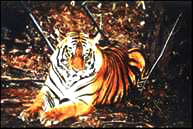| Crossing
territorial boundaries |
 |
Nepal's
Animals |
|
|
 |
 |
 |
Could
the Royal Bengal tigers of India's Jim Corbett National Park ever make
it to enter Royal Bardiya National Park in Nepal's western Terai? A Jim
Corbett Park NP's tiger has managed to cross over to Nepal. There are speculations
that a herd of wild Asiatic elephants living in Bardiya Park for the last
few years could have come all the way from Jim Corbett NP, which lies at
least 600 kilometres away from Bardiya. |
Nepal's
western Terai will have more greenery with adequate forest corridors for
the wildlife which know no political boundaries.
If
things go as planned, the rare Asiatic elephants, rhinos and Bengal tigers
living in six protected areas of Nepal and India will find it even more
easier to cross over into each other's territory within the next few years.
As such, like the people of these two neighbours, animals too do not need
any passport or any document whatsoever to cross over to India or vice-versa.
The only problem, say experts, is that there is not enough forest cover
or corridor for these animals. The Ministry of Forest and Soil Conservation
of the government of Nepal and World Wide Fund for Nature Conservation
(WWF) Nepal programme have now joined forces one more time to conserve
and maintain a suitable habitat for the critically endangered wildlife
species in the Western Terai.
The
Terai-Duar Savannas and Grasslands of Nepal are one of the 'Global 200
Ecoregions' identified by WWF. The two sides this time are out to reforest
the badly deforested patches from Banke-Bardiya to Kailali-Kanchanpur area
in an attempt to create forest corridors linking the protected nature reserves,
thereby facilitating the movements of the wildlife between the two nations.
And the easy movement of such endangered species as tigers, elephants and
rhinos are of utmost importance for the animals' survival and long-term
conservation, say experts. "It's the best move," says Conservation Biologist
Shanta Raj Gyawali of King Mahendra Trust for Nature Conservation (KMTNC).
"The wild animals from different isolated parks need to mix in order to
survive." He says continuous breeding of wild animals within a single population
creates problems, and could even turn males infertile on the long run.
"That's why corridors and inter-population relations are necessary," he
adds.
Nepal's
Bardiya National Park and Shukla Phanta Wildlife Reserve adjoins India's
(Uttar Pradesh state's) Katraniaghat Wildlife Sanctuary and Dhudhwa National
Park, and Kishanpur Wildlife Reserve, respectively. India's Sohelwa Wildlife
Reserve and Jim Corbett National Park are also located within the 500-km
radius of this area. Secretary at the Ministry Rabi Bahadur Bista and other
high-ranking officials, WWF Nepal Program officials and the country's noted
conservation biologists, last week extended their commitment to help carry
out the five year project - Western Terai Chure Conservation Program. Bista
formally opened the Program's office in this far-western Terai town Saturday.
WWF
Nepal program is providing a financial assistance totalling US $ 1 million
for the five-year-long project. "The government is committed (to conserving
bio-diversity)," Bista said Saturday. "How committed we are is clear from
the fact that we are not allowing to cut down a single tree in this region
(mid- and far-west) for another five years." Officials say, some 1.5 million
locals, the guardians of the forest resources, from the Bardiya Park's
proposed extension area in Banke to Tanakpur near Shukla Phanta Wild Life
Reserve, will be directly involved to conserve the forests and wetland
of the Western Chure area. The region is home to dozens of critically endangered
animals like Royal Bengal tigers, Asiatic elephants, One-horned rhinos,
Swamp deer, Gangetic dolphins and hundreds of bird species.
The
region boasts of three different Tiger Conservation Units (TCUs) - Banke-Bardiya,
Kailali Dudhwa and Shukla Phanta-Kishanpur - which are famous for their
"extremely
high
density" of tiger population.
Report:
2002
|



